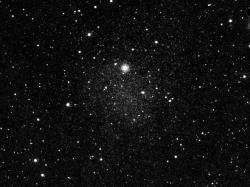Stars in galaxies are a bit similar to people: during the first phase of their existence they grow rapidly, after which a stellar birth control occurs in most galaxies. Thanks to new observations from Dutch astronomer Mariska Kriek with the Gemini Telescope on Hawaii and the Very Large Telescope in Chile, it is now known that a part of the heavy galaxies already stopped forming stars when the universe was still a toddler, about three billion years old.
Astronomers suspect that black holes exert an influence on this halt in births.
Heavy galaxies are a boring phenomenon in the modern universe. They have an elliptical or a round form, the stars are evenly distributed over the galaxies and no more new stars are formed. The large quantities of stars, about 10 billion, and the current, low birth rate point to the fact that star formation must have been much higher in the past. When were these stars formed and why did the star formation subsequently stop?
The finite speed of light makes it possible to study the universe when it was much younger than now. With the help of spectrographs, such as the Gemini Near-InfraRed Spectrograph and SINFONI on the VLT, Mariska Kriek and her colleagues studied 36 heavy galaxies in the early universe. These galaxies are so far away that the light from them has taken 11 billion years to reach us.
Interestingly the researchers found no signs of star formation for a large proportion of the galaxies observed. This new discovery contributes to the growing mass of evidence that the formation of new stars in heavy galaxies is strongly inhibited after an explosive baby boom.
This 'halt in births' is possibly due to the influence of the enormous black holes in the middle of the galaxies. The large amount of material attracted by these black holes generates enormous quantities of energy that subsequently heats up the gas in the galaxy. As a result of this heating the gas is no longer able to form new stars. The researchers did indeed discover a black hole in a number of the galaxies they investigated. These were mainly the galaxies where the star formation was inhibited less than 1 billion years ago. These results support the idea that black holes limit the birth of new stars.
Source: Netherlands Organization for Scientific Research
























